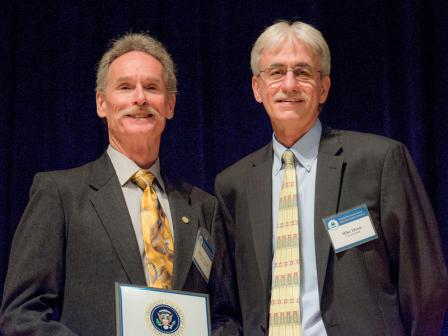EPA Honors California Environmental Educators (August 2017)
EPA has announced that John Wood, a teacher at Samuel E. Talbert Middle School in Huntington Beach, Calif., is one of six winners to receive the Presidential Innovation Award for Environmental Educators (PIAEE). The PIAEE awards recognize innovative educators who bring environmental education into their classrooms through hands-on, experiential approaches. Shelley Glenn Lee, a teacher at High Tech Elementary North County in San Marcos, received an honorable mention. EPA honored these educators, along with winners of the President’s Environmental Youth Award, at a series of events in Washington, D.C. in August 2017. Twelve educators and 75 students from across the nation were recognized for their exceptional contributions to environmental education and stewardship.
 John Wood with Acting Deputy Administrator Mike FlynnJohn Wood is a 6th through 8th grade science teacher at Samuel E. Talbert Middle School. He has more than 28 years of experience and he uses unique methods to engage students in learning about the effects of environmental changes from the Alaskan and the Siberian tundra. By using web-based tools, his students have joined research expeditions to monitor water quality and other environmental changes on the glaciers of Mount Kilimanjaro. Mr. Wood enlists climate scientists to begin interactive blogs with students to help develop personal and professional collaboration.
John Wood with Acting Deputy Administrator Mike FlynnJohn Wood is a 6th through 8th grade science teacher at Samuel E. Talbert Middle School. He has more than 28 years of experience and he uses unique methods to engage students in learning about the effects of environmental changes from the Alaskan and the Siberian tundra. By using web-based tools, his students have joined research expeditions to monitor water quality and other environmental changes on the glaciers of Mount Kilimanjaro. Mr. Wood enlists climate scientists to begin interactive blogs with students to help develop personal and professional collaboration.
Beyond the classroom, Mr. Wood offers students additional opportunities to become involved. He is the advisor for the school’s first after-school, student-led Global Learning and Observation to Benefit the Environment club, where students learn basic protocols for data collection and brainstorm ways to spread awareness of these issues to their local communities. The club has been involved in projects to make the school greener through recycling efforts. Mr. Wood was recognized as Teacher of the Year for Orange County in 2013 and Teacher of the Year in Earth Sciences in 2016.
Presidential Innovation Award for Environmental Educators Honorable Mention
Shelley Glenn Lee, High Tech Elementary North County (San Marcos, CA)
Ms. Lee is a science teacher with more than 20 years of experience who takes students from kindergarten through 5th grade into the field to conduct research, learn about local and global environmental issues, and share their work with others. She designed Tidepool Treasures, a project for kindergarteners and first graders centered on the concepts of habitat. By building small freshwater habitats that sustain snails, worms and fish and conducting fieldwork, the students learn how to connect with local biodiversity and think like scientists by making observations and recording their findings. The students also participate in the school’s Kindergarten Conservation Series, a project that integrates reading, writing, math and art by challenging students to investigate their local habitat and to write books that promote conservation.
Northern California Students Recognized for Environmental Stewardship
EPA also honored outstanding environmental stewardship projects by K-12 youth with the President’s Environmental Youth Awards. The 15 winning student projects, first announced in June 2017, included two from Northern California and these students were recognized at the August 2017 events in Washington, DC.
Mount Madonna School (Watsonville, CA)
A group of 17 fifth grade students won the award for their year-long project focused on environmental threats faced by the Western Snowy Plover, a threatened shorebird found along the California coastline. The students worked with a local biologist to write reports and create displays on environmental threats and conservation efforts related to the Western Snowy Plover. Additional activities included creating a 30-minute educational film; reestablishing habitat at a local state beach by planting native plants; and creating nesting sites in salt flats near Elkhorn Slough. The group also designed and tested a small-scale sand dune to assess its ability to hold a plover nest exposed to the elements.
The Grey Water Project (Fremont, CA)
Thirteen-year-old Shreya Ramachandran won the award for her study of grey water use in water conservation. Having seen firsthand the effects of drought in California and in India, Shreya began researching ways to conserve and reuse water. Shreya found that many commercial laundry detergents include chemicals that can be detrimental to soil, plants and aquatic life. To address this, she conducted tests to see if grey water from soap nuts—a natural laundry detergent derived from the Indian soap berry—could be used as irrigation water without harming the environment. She conducted multiple tests, comparing grass that had been exposed to regular water, soap-nut grey water, organic and non-organic detergent grey water. She found that soap nut grey water was beneficial to plant growth and cost less than an organic detergent.
